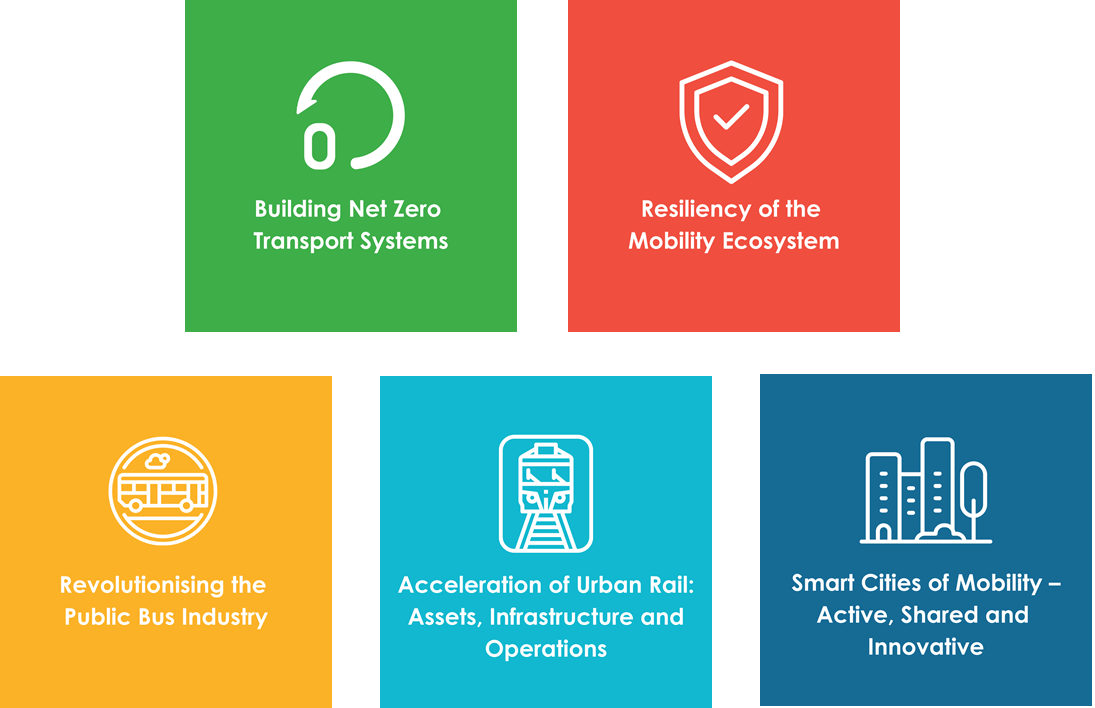5 Main Congress Streams
Heartbeat of Mobility
SITCE 2022 Congress will feature 5 main congress streams with over 30 sessions, aiming to address challenges and raise solutions for urban mobility planners, operators, service providers, innovators, start-ups and researchers to come together in shaping the future of urban mobility landscape.
The theme of the congress is Heartbeat of Mobility.
It will address the full range of urban mobility technologies, planning, systems and solutions, comprising the topics below:

Building Net Zero Transport Systems
Public transport is on the world’s climate change agenda. This sector must proactively look at ways to reduce carbon emission while dramatically improve ridership as a green transport mode itself.
- Net-zero systems by design for cities (including green mobility strategies and cities’ decarbonisation plan through transport)
- Leadership in low carbon emission transport systems focuses on cultural changes and incentives required from commuters and operators in reducing carbon emission.
- Innovative sustainable transport and road management policies and electronification of public transport (focus on reducing carbon emission objectives)
- Environmental sustainability goals and operations (including strategies to improve energy efficiency of public transport operations and environmentally-friendly approach to infrastructure developments.
- Sustainability and green financing in public transport
Resiliency of the Mobility Ecosystem
The transport sector must continue to move forward by building a resilient mobility ecosystem where service providers must put passengers first, be proactive in safety and security management as well as having a sustainable outlook on operating model and funding.
- Crisis and recovery management (pandemic/ epidemic measures, emergency and disruption management, etc.)
- Resilient transport systems and services where the infrastructure, systems and processes are designed with flexibility to handle changing demand and environment (e.g. climate change)
- Cyber security, operational safety and security e.g. cyber-attacks, data breach, risk management of assets and infrastructure, etc.
- Sustainable operating models – including digitalisation, outlook on talent management (diversity and equality), and revenue management
- ‘Customers first’ – innovative policies and strategies where commuters are at the heart of PT planning
- Sustainable funding sources and mechanism (including PT fares formulas, road-based pricing – financing schemes of partnerships (PPP, Startups, etc.
Revolutionising the Public Bus Industry
Transforming the bus industry often includes reform of bus service planning, fleet procurement and management, talent management, digitalisation of operations, funding and many more. This stream will feature best practices and innovative use cases from the public bus sector.
- Electrification of buses (focus on technology)
- Autonomous Bus – regulations and operations
- Optimising bus operations and infrastructure (focus on local innovations and/ or technical innovations).
- Bus workforce management including embracing workforce into the future of digitalisation
- Rise of on-demand solutions in the public bus sector
Acceleration of Urban Rail: Assets, Infrastructure and Operations
Urban rail is undergoing through rapid changes. This stream will focus on the adoption of innovation and technological solutions necessary for urban railways to continue to excel and flourish in our cities.
- Infrastructure and construction technology
- Integration of technology into asset management and infrastructure (rolling stock, signaling systems, Wi-Fi connectivity, etc.)
- Breakthrough in digital railways (digital twin simulations, AI, image recognition technologies, etc.)
- Future of railway networks (high speed rail, hyperloop)
Smart Cities of Mobility – Active, Shared and Innovative
Smart cities’ goals are to ensure that urban mobility is seamless, efficient and diverse. They also mean that mobility would withstand disruptions and provide a variety of options for the diverse needs of commuters.
- Integrated mobility – walk, cycle, ride, MaaS
- Micromobility as first-and-last mile connections – trends and governance (PMDs, air taxis)
- Sharing mobility governance and operations – car-sharing, carpooling, ride-hailing
- Use of advance technologies in public transport management and planning (e.g. AI in city management)
- Seamless travel through seamless fare collection (automatic fare collection trends)